31 Current Voltage And Resistance Worksheet
ACTIVITY 1: Current, Voltage and Resistance. • Use an ammeter and voltmeter to take readings in virtual circuits. • Discover the relationship between voltage, current and resistance in circuits. Current is the rate of flow of electric charges. Voltage (potential difference) is the energy used by every unit charge to move from one point to. This electricity resource asks KS3 students to sort statements relating to current voltage and resistance into the correct groups. When their answers have been checked they create a mindmap with the information. Each student then uses their map to describe the three terms to their partner. The challenge then is to recreate the mindmap. Answers are included.
Potential Difference, Resistance and Current - Worksheet. This worksheet is designed for GCSE Physics students. It includes a series of questions of increasing challenge, with answers and extra supporting videos available at the link on the bottom of each page or via the QR code. Full written answers and a video explanation for this worksheet.

Current voltage and resistance worksheet
f) If the resistance of a circuit is quadrupled, by what factor does the current change? 1/4th g) Fill out the table for the circuit diagramed at the right. 0.3 h) Is there a relationship between resistance and voltage drop in a series circuit? If so, state it. Ohm’s Law: V = IR c) If the resistors were light bulbs, explain in terms of charge. A wire has resistance of 21 ohm. It is melted down and from the same volume of metal a new wire is made, that is three times longer than the original one. What is the resistance of new wire Problem 2: The filament of a 100-W bulb carries a current of 0.83 A at the normal operating voltage of 120 V. A. What is the resistance of the filament? B. resistance allows a large amount of current to flow. Resistance is measured in ohms. ( P ) Power is the amount of current times the voltage level at a given point measured in wattage or watts. Lesson Introduction: Ohms law, sometimes more correctly called Ohm's Law, named after Mr. Georg Ohm, mathematician and physicist born 1789 and died.
Current voltage and resistance worksheet. OHMS LAW AND POWER You will need to learn to use these equations: Voltage = Current x Resistance or V = IR Power = Current x Voltage or P = IV Now try these questions - show your working out: Question 1 A torch is operated by a 3v battery. When the switch is closed the bulb draws 0.075 Amps from the battery. What is the resistance of the bulb? Question 2 A toy car with an electric motor draws. Explain what the electrical terms voltage, current, and resistance mean, using your own words. file 00008 Question 3 What units of measurement are used to express quantities of voltage, current, and resistance? file 00181 Question 4 Voltage is also known by another name: electromotive force, or EMF. Explain what this other name for voltage means. Voltage Current and Resistance how they can be measured as well as their relationships according to ohms law. This worksheet is designed for GCSE Physics students. Current voltage and resistance worksheet answers pdf. Section 6 Current Voltage and Resistance in Parallel and Series Circuits. Riya connects an electrical circuit. a. What is the total resistance of the circuit? b. What current flows from the battery? c. What is the current through, voltage across and power dissipated by the 300 Ω resistor? d. Which of the values (if any) would be the same for the 700 Ω resistor? e. What power rating does the battery require to keep the voltage and current constant? 2.
The amount of current in a circuit depends on the amount of voltage and the amount of resistance in the circuit to oppose current flow. Just like voltage, resistance is a quantity relative between two points. For this reason, the quantities of voltage and resistance are often stated as being “between” or “across” two points in a circuit. To determine the relationship of voltage, current, and resistance in an electric circuit In this lab activity you will use a Digital Multimeter (DMM) to measure voltage, current, and resistance in different sections of an electric circuit. You will see how the flow of current and the voltages are distributed around the circuit. CIRCUITS WORKSHEET. 1. Determine the equivalent (total) resistance for each of the following circuits below. 2. Determine the total voltage (electric potential) for each of the following circuits below. 3. Fill out the table for the circuit diagramed at the right. Voltage (V) Current (A) Resistance (Ω) Power (W) 1 10.0 2 20.0 3 30.0 Total 6.00 g) How does the voltage drop across each branch in a parallel circuit compare? h) If the resistors were light bulbs, explain in terms of charge flow (current) and energy per charge (voltage) which bulb would be brightest / dimmest. 5.
Introduce students to Voltage, Current and Resistance and how to use Ohm's Law with this double sided jumbo sized ledger worksheet.- Voltage (Potential Difference), Current and Resistance explained.- Digital Multimeter as a measurement device of VIR- Ohm's Law equation and practice questions.Worksh Combining the elements of voltage, current, and resistance, Ohm developed the formula: Where V = Voltage in volts I = Current in amps R = Resistance in ohms This is called Ohm's law. Let's say, for example, that we have a circuit with the potential of 1 volt, a current of 1 amp, and resistance of 1 ohm. Using Ohm's Law we can say: Mar 05, 2018 · Ohm’s law graph is a plot of voltage and current where the voltage is plotted on the x-axis and current is plotted across the y-axis. In our experiment on 1 k resistor, we observed a straight linear relationship between Ohm’s law.Today you’ll learn the behavior of slop with the resistance. Let’s check the Ohm’s law plot for different resistors. Current, voltage and resistance calculations. A simple worksheet of questions for pupils to use to practice calculations with the V = IR equation.
Physics P Worksheet 22-1 Current, Voltage, Resistance, and Power 1. q=ne q=(4×1018 electrons)(1.6×10-19 C/electron) q=0.64 C I= q t I= 0.64 C 0.5 s I=1.3 A Since the conventional current is the flow of positive charge we will ignore the fact that electrons are negative and give the current as a positive value.
Displaying top 8 worksheets found for - Calculate Current Resistance And Voltage. Some of the worksheets for this concept are Resistance calculations work, Equivalent resistance work, Electrical circuit calculations, Current voltage and resistance, Grade 9 science unit 3 electricity, Circuits work r, Voltage drop, Physics work.
resistance allows a large amount of current to flow. Resistance is measured in ohms. ( P ) Power is the amount of current times the voltage level at a given point measured in wattage or watts. Lesson Introduction: Ohms law, sometimes more correctly called Ohm's Law, named after Mr. Georg Ohm, mathematician and physicist born 1789 and died.
Current, voltage and resistance Current is the rate of flow of electric charge. A potential difference (voltage) across an electrical component is needed to make a current flow through it.
In a series circuit, certain general principles may be stated with regard to quantities of voltage, current, resistance, and power. Complete these sentences, each one describing a fundamental principle of series circuits: ``In a series circuit, voltage. . .’‘ ``In a series circuit, current . . .’‘ ``In a series circuit, resistance
Voltage: electrical "pressure" between two different points or locations. Current: the flow of electrons. Resistance: opposition, or "friction," to the flow of electrons. Notes: While it is easy enough for students to look up definitions for these words from any number of references, it is important that they be able to cast them into their own words.
Worksheet Current, Voltage, Resistance and Ohm's Law. by. Science Master. 6. $1.99. PDF. This worksheet contains questions of various types. (Fill in the blanks, matching, true or false, classification, open ended, critical thinking, etc.) It can be used for review, practice or assessment purposes.
In this physics worksheet, students construct the circuit shown in the problem and calculate either voltage, current and resistance. They solve 37 circuit related questions. In this Ohm's Law worksheet, students answer 8 questions which include multiple choice, graphs, and short answer.
Section 6 Current, Voltage, and Resistance in Parallel and Series Circuits: Who's in Control? AP-2ND_SE_C6_v3.indd 647 4/27/09 10:35:39 AM. Chapter 6 Electricity for Everyone Active Physics 648 In the next parallel circuit diagram, the 9 A are shown in packets of 3 A,
Required practical - investigate current - voltage graphs. There are different ways to investigate the relationship between current. and potential difference . In this required practical activity.
Current voltage and resistance displaying top 8 worksheets found for this concept. Voltage is always measured between two points. Physics energy and electricity. Tell whether each picture shows a series circuit or parallel circuit. Solve for the unknown measurement. V 110 v 2. I 25 ma a. R 20 ω v 350 mv v b r.
Visualizing Current, Voltage and Resistance. applet simulation worksheet.doc - 27 kB. Download all files as a compressed.zip. Title. Visualizing Current, Voltage and Resistance. Description. Students will go from station to station working with a different simulation to better visualize current, voltage and resistance. Subject.
Voltage Divider Circuits. In this physics worksheet, students construct the circuit shown in the problem and calculate either voltage, current and resistance. They solve 37 circuit related questions. In this electricity law worksheet, students complete 16 short answer and problem questions on Ohm's law.
Current voltage and resistance worksheet answers pdf. Determine the equivalent total resistance for each of the following circuits below. Explain if you can the relevance of these facts to electrical safety. Current may be measured at a single point at a cross section of a conductive path. The voltage of the circuit.
Worksheet: Parallel Circuit Problems - Episode904 Name Remember that in a parallel circuit: the current in the branches of the circuit (is the same, adds up). the voltage drops across each branch (is the same, adds up to) the total voltage. to calculate total resistance, (add, use reci rocals). 24v 20Q VT = Ho v eq RI - 24Q VI RI R2 6 R eq 12v.
A wire has resistance of 21 ohm. It is melted down and from the same volume of metal a new wire is made, that is three times longer than the original one. What is the resistance of new wire Problem 2: The filament of a 100-W bulb carries a current of 0.83 A at the normal operating voltage of 120 V. A. What is the resistance of the filament? B.
Question 3. Explain what the electrical terms voltage, current, and resistance mean, using your own words. Voltage: electrical “pressure” between two different points or locations. Current: the flow of electrons. Resistance: opposition, or “friction,” to the flow of electrons. These three are related through Ohm’s Law.
Aug 24, 2021 · Ohm's Law. The relationship between voltage, current, and resistance is described by Ohm's law.This equation, i = v/r, tells us that the current, i, flowing through a circuit is directly.
ID: 761801 Language: English School subject: Science Grade/level: 9 Age: 12-15 Main content: Voltage, current, resistance calculations. Other contents: Add to my workbooks (7) Download file pdf Add to Google Classroom Add to Microsoft Teams
Voltage, Current and Resistance This worksheet provides a YouTube lesson explaining electricity and its variables; Voltage, Current and Resistance, how they can be measured as well as their relationships according to ohm's law.
1. Determine the equivalent (total) resistance for each of the following circuits below. 2. Determine the total voltage (electric potential) for each of the following circuits below. 3. Fill out the table for the circuit diagramed at the right. Circuit Position Voltage (V) Current (A) Resistance (Ω) 1 10.0 2 20.0 3 30.0 Total 6.00 4.
f) If the resistance of a circuit is quadrupled, by what factor does the current change? 1/4th g) Fill out the table for the circuit diagramed at the right. 0.3 h) Is there a relationship between resistance and voltage drop in a series circuit? If so, state it. Ohm’s Law: V = IR c) If the resistors were light bulbs, explain in terms of charge.
CIRCUITS WORKSHEET 1. Determine the equivalent (total) resistance for each of the following circuits below. 2. Determine the total voltage (electric potential) for each of the following circuits below. 3. Fill out the table for the circuit diagramed at the right. Circuit Position Voltage (V) Current (A) Resistance (Ω) 1 10.0 2 20.0

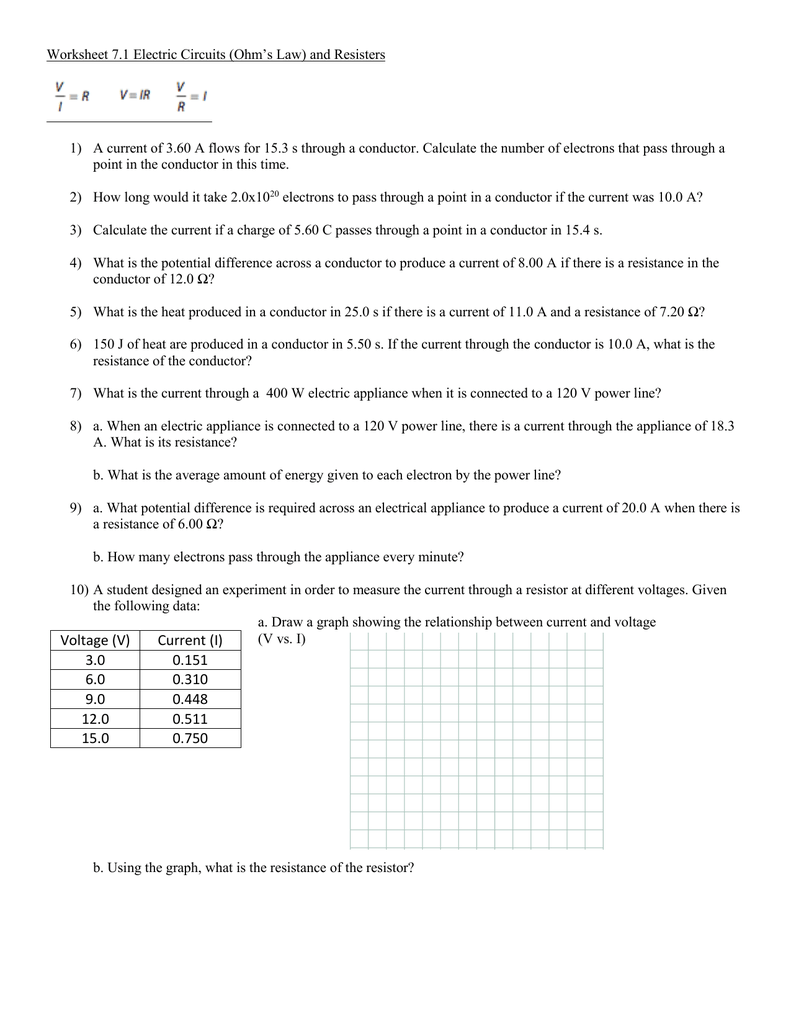

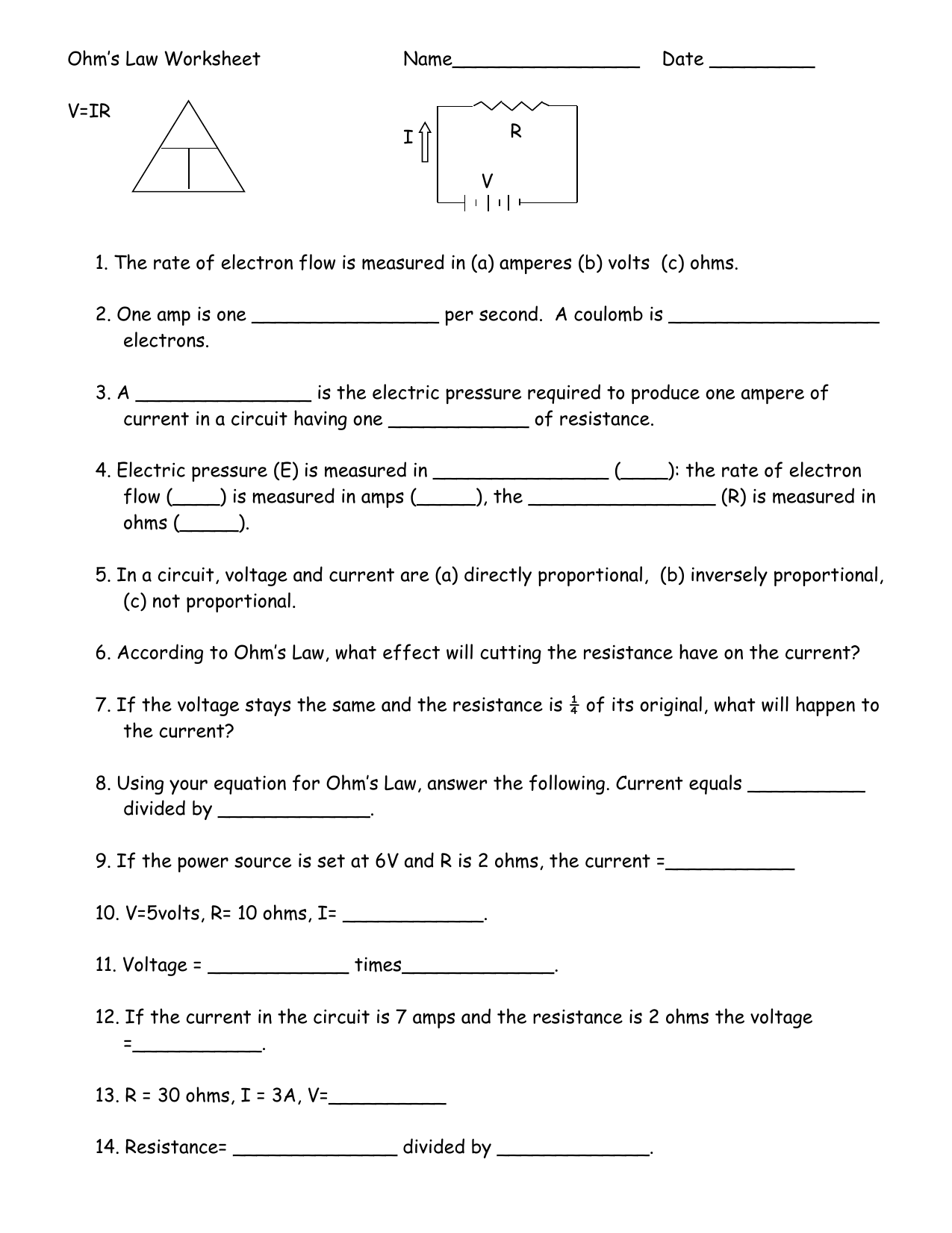
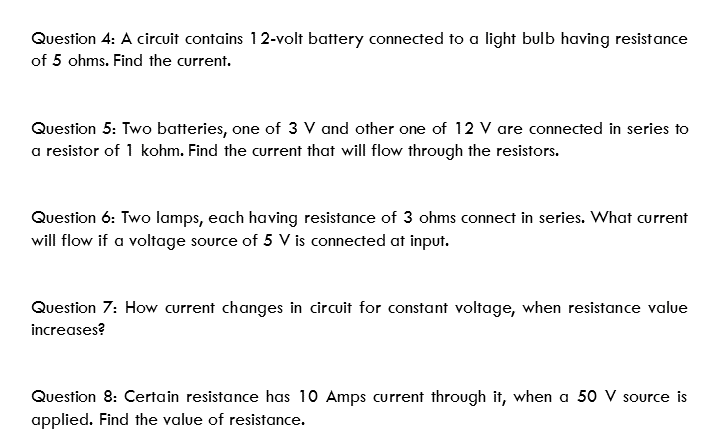





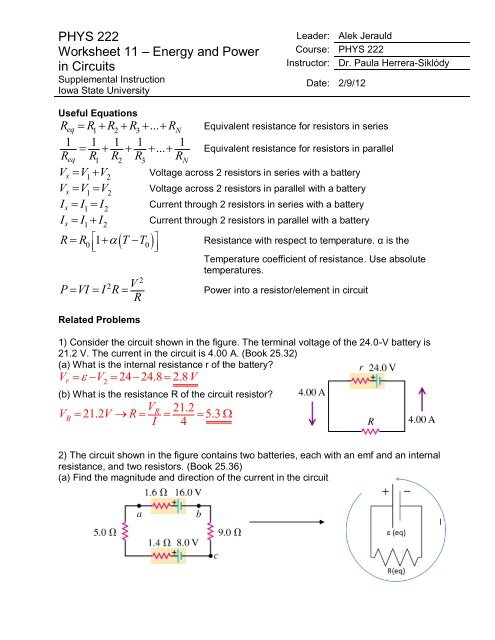
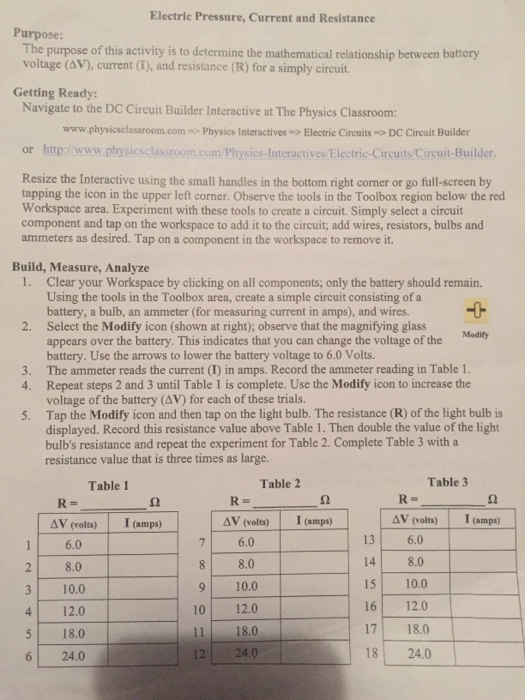



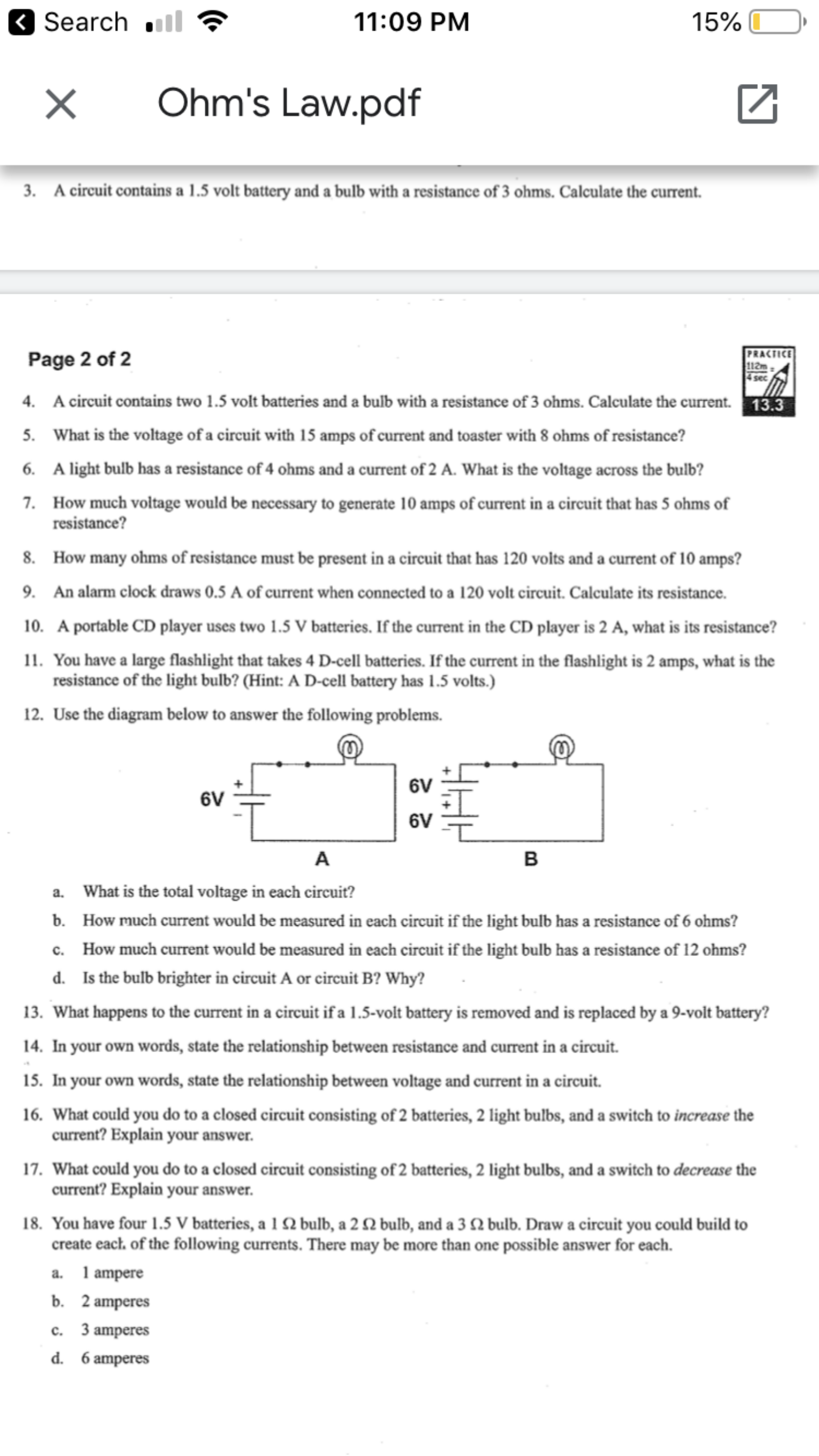
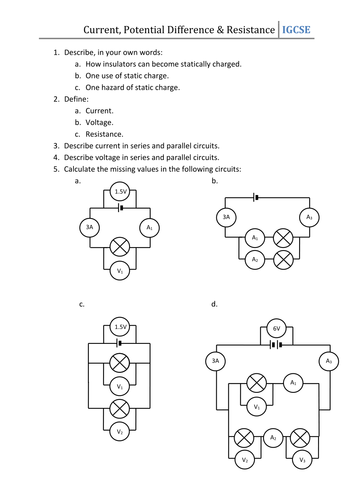









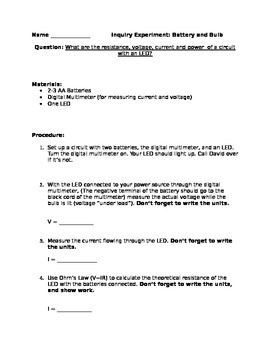

0 Response to "31 Current Voltage And Resistance Worksheet"
Post a Comment